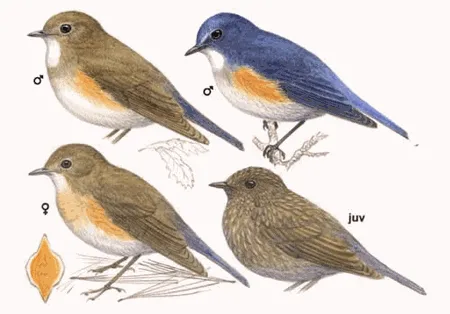
Red-flanked Bluetail
[order] PASSERIFORMES | [family] Muscicapidae | [latin] Tarsiger cyanurus | [UK] Red-flanked Bluetail | [FR] Rossignol bleu | [DE] Blauschwanz | [ES] Coliazul cejiblanco | [NL] Blauwstaart
Subspecies
Monotypic species
Physical charateristics
Close in size and structure to European Robin, though slightly shorter billed and longer tailed. Small, fairly compact chat, with general character recalling both European Robin and Redstart.Female dull olive-brown above, with pale eye-ring and darker, blue-washed rump and tail, dull white below, with brown chest and orange flank-panel.
Sexes disimilar, no seasonal variation.
Sexes disimilar, no seasonal variation.
Listen to the sound of Red-flanked Bluetail
[audio:http://www.aviflevoland.nl/sounddb/R/Red-flanked Bluetail.mp3]
Copyright remark: Most sounds derived from xeno-canto
| wingspan min.: | 22 | cm | wingspan max.: | 23 | cm |
| size min.: | 13 | cm | size max.: | 15 | cm |
| incubation min.: | 12 | days | incubation max.: | 13 | days |
| fledging min.: | 0 | days | fledging max.: | 13 | days |
| broods: | 1 | eggs min.: | 5 | ||
| eggs max.: | 7 |
Range
Eurasia : North Eurasia from Finland to Japan
Habitat
Breeds in upper-middle and marginally in upper continental latitudes, exclusively boreal and mountain, in thick mossy conifer forest, especially taiga, on moist soil, generally with undergrowth.
Also mixed forest with birch and rhododendron. In Far East, more often in birchwoods, even up to 3000 m in Japan, where trees no more than 3 m high.
Also mixed forest with birch and rhododendron. In Far East, more often in birchwoods, even up to 3000 m in Japan, where trees no more than 3 m high.
Reproduction
Breeding starts June-August in former USSR. Nest site is on ground in hollow among tree roots, or in hole in bank, or slightly above ground in stump or fallen log. Nest cup consists of moss, grass, and roots, lined with softer grass, wool, hair, and sometimes pine needles. 5-7 eggs incubated by female.
Feeding habits
Diet based on insects, also fruits and seeds outside breeding season. Feeds in low trees, shrubs, and on ground.
Catches insects by hopping about on ground, by perching and flying down to take items located, and by brief aerial-pursuit like flycatcher.
Catches insects by hopping about on ground, by perching and flying down to take items located, and by brief aerial-pursuit like flycatcher.
Conservation
This species has an extremely large range, and hence does not approach the thresholds for Vulnerable under the range size criterion (Extent of Occurrence <20,000 km2 combined with a declining or fluctuating range size, habitat extent/quality, or population size and a small number of locations or severe fragmentation). The population trend appears to be stable, and hence the species does not approach the thresholds for Vulnerable under the population trend criterion (>30% decline over ten years or three generations). The population size has not been quantified, but it is not believed to approach the thresholds for Vulnerable under the population size criterion (<10,000 mature individuals with a continuing decline estimated to be >10% in ten years or three generations, or with a specified population structure). For these reasons the species is evaluated as Least Concern.
Tarsiger cyanurus has a predominantly Asian distribution, but its breeding range
also extends into the boreal zone of European Russia and Finland. Its European
breeding population is relatively small (<21,000 pairs), but was stable between 1970- 1990. No trend data were available for the stronghold Russian population during 1990-2000, but the small population in Finland increased
Tarsiger cyanurus has a predominantly Asian distribution, but its breeding range
also extends into the boreal zone of European Russia and Finland. Its European
breeding population is relatively small (<21,000 pairs), but was stable between 1970- 1990. No trend data were available for the stronghold Russian population during 1990-2000, but the small population in Finland increased

Migration
West Palearctic populations are long-distance migrants (wintering from Burma east to southern China and Taiwan). (Southern race rufilatus, breeding Himalayan region and western China, mainly shows short-distance altitudinal movements.) West Palearctic birds therefore make long easterly movements (in autumn), passing north of major central Asian mountain systems, before turning south through Mongolia and China. Autumn migration begins early September; northern edge of range deserted by mid-September. Return passage begins April, vanguard reaching southern Siberia in second half of April. Spreads north and west during May, reaching Arkhangel?sk region around 20 May-4 June.
Distribution map

